IT'S IMPORTANT TO REGULARLY CHECK THE TYRES ON YOUR TRAILER
For your safety and also to make sure that your trailer is reliable, it is important that you regularly carry out thorough checks to establish the general condition of your trailer and its tyres. A good set of tyres and a stable load increase road safety significantly.
TYRE PRESSURE AND TYRE WEAR
The tyres on your trailer are the only parts of the trailer that are in direct contact with the road surface. This explains why the condition of your tyres largely determines a trailer's grip on the road and its road handling. Tyre pressure and tyre tread in particular majorly affect the safety of your means of transport. With this in mind, we advise that you check the tyres on your trailer for the following every two weeks:
- Tyre pressure
- Tread depth
- Irregular wear
- Cracks in the sidewalls
If in any doubt, always contact your Hapert Dealer.
WHY IS OPTIMUM AIR PRESSURE SO IMPORTANT?
- Fuel consumption is lower
- Optimum grip on the road is achieved
- The risk of skidding is reduced significantly
- You achieve an optimal stopping distance
- Irregularities in the road surface are absorbed effectively
- Steering behaviour is optimal
- Improved stability results in maximum driving comfort
- Road handling is optimal
- Trailer tyres last longer
- The chance of a burst tyre is minimised
THE CORRECT PRESSURE IN FIVE STEPS
- It takes just five easy steps to achieve the correct tyre pressure for the tyres on your trailer:
- Check your tyre pressure before you use the trailer or before you have driven more than five kilometres.
- Check the tyre pressure table and find the appropriate pressure for your type of trailer. Next, set the tyre pump to the tyre pressure required.
- Loosen the valve cap on the tyre by turning it anticlockwise.
- Connect the pump to the valve. Keep the nozzle straight and firmly in place until the appropriate tyre pressure has been achieved and you hear a beep. Once finished, put the valve cap back onto the trailer tyre.
- Don't forget to check the tyre pressure of the spare wheel.
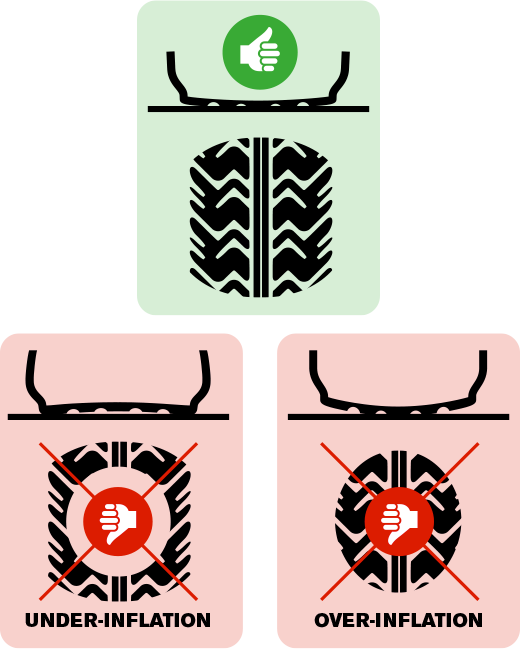
CHECKING TYRE PRESSURE
The correct tyre pressure promotes road handling and improves road safety. If tyre pressure is optimal, the trailer will brake better, there will be a minimal risk of swerving, tyre wear will improve and the chance of a burst tyre will become significantly lower. You will use less fuel too. All in all, it is vital to check your tyre pressure on a regular basis.
TYRE PRESSURE AND YOUR HAPERT TRAILER
The optimum tyre pressure for your HAPERT trailer
will depend on the type of tyre you are using.
The tyre pressure table below shows the
appropriate tyre pressure and also
the maximum load per type of tyre.
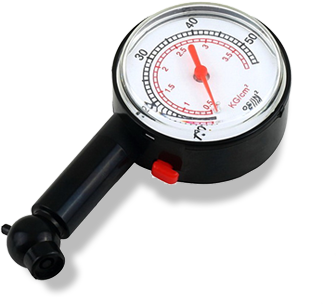
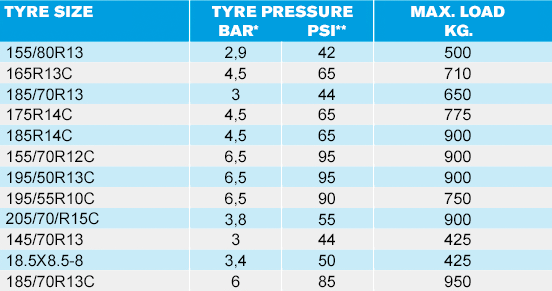
* The Bar pressure-unit is used to indicate tyre pressure.
** Pound per Square Inch is a unit of pressure that is used primarily in the United Kingdom and the United States.
WHICH INFORMATION WILL YOU FIND ON A TYRE?
The information provided on the side of a tyre tells you about the construction and properties of the tyre in question:
- Tyre brand
- Tread markings and tyre type
- Width of the tyre in mm
- Ratio of the tyre height to the tyre width in %
- R= Radial tyres and D= Diagonal tyres
- Diameter of the rim in inches
- Reference for the load bearing strength of the tyre
- Speed category
- Tubeless (tyres without an inner tube)
- Production date (XX = Week, X = Year, < = 9. Decade)
- Wear index – TWI
- Added to tyres with an increased load-bearing strength (reinforced)
- An indication of suitability for use during the winter months (for winter and all-year tyres). Winter tyres are identified by the abbreviation "M+S" (Mud and Snow) or other, similar markings. This makes this type of tyre recognisable as being designed for use in a certain weather type and also has direct consequences for its speed-category positioning.
- For Trailer Use Only: all of our tyres are for ‘trailer use only’. This is because of the relatively low maximum speed for which the tyres are suitable, being a maximum of 140 km/h.
- DOT number: you can find out how old your trailer tyres are from the number indicated on them; we call this the DOT number. Look at the last four digits of this number: 2514, for example. This indicates that your tyre was manufactured in Week 25 of 2014. Regardless of how much or little they are used, trailer tyres must always be changed within seven years of their manufacture date at the very latest.
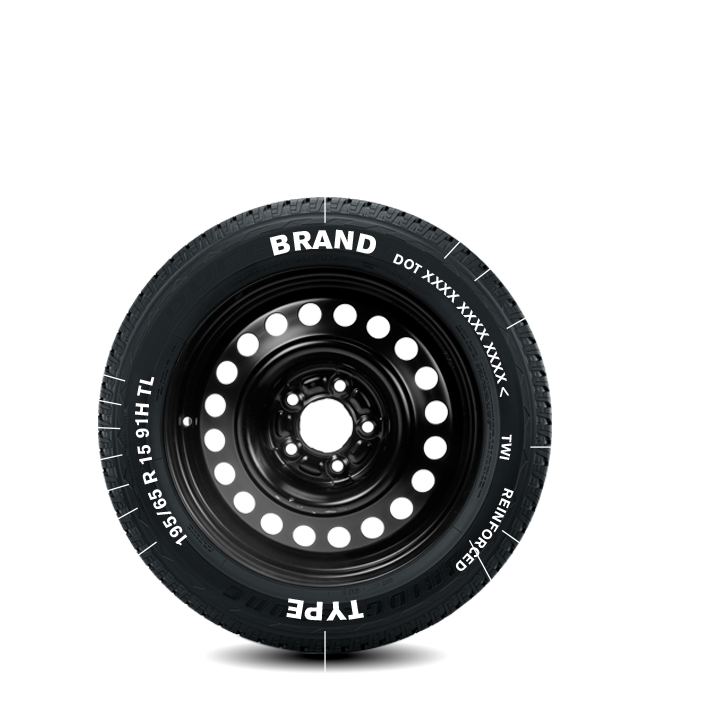
MEASURING TYRE TREAD
Trailer tyres lose their tread depth through wear over time. It is against the law to drive with tyres that have an overall tread depth of less than 1.6 mm. We describe two easy ways for you to check tyre tread yourself below.
TWI WEAR-INDICATOR
You will see the abbreviation TWI (Tread Wear Indicator), a triangle or the brand logo on a number of places on the side of the tyres on your trailer. This wear indicator, which consists of a small block that is 1.6 mm thick, enables you to see how worn your tyres are straight away. The wear limit will have been reached once you can see the block indicated above.
TYRE-TREAD GAUGE
A slide gauge or tyre-tread gauge makes it easy to measure the tread on a tyre. Always make sure that you measure the tread in three places: the middle, inside and outside of the tyre. This is important because the tyres on your trailer may wear more in one area than they do in others. With this in mind, the tread depth of a tyre is always determined on the basis of the lowest tread measured.
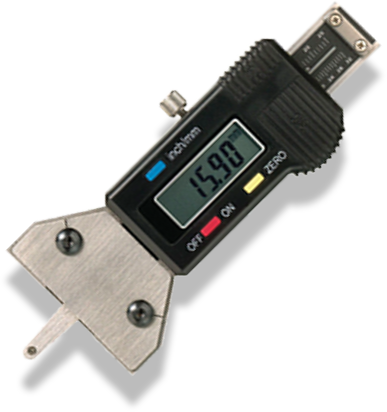
HOW OLD ARE THE TYRES ON MY TRAILER?
- Besides tread depth, other signs that will help you to recognise a damaged tyre:
- Drought cracks: these cracks are a sign that the tyres you are using are old. Bear in mind that, although a tyre might still look good after having being stored for the winter, you may only see drought cracks once you have driven on a tyre for several kilometres. So, check your tyres again when you have driven on them for a short distance.
- Bulging: a tyre may bulge if you hit a curb while driving or drive over a pothole. This impact to the outer tyre causes both internal and external damage to the tyre as a whole. You may find that your tyre bursts as a result.
WOULD YOU LIKE MORE INFORMATION ABOUT YOUR TRAILER TYRES?
If you would like more information about how to check the tyres on your HAPERT trailer, visit a HAPERT dealer near you. Our specialists there will be pleased to help!

